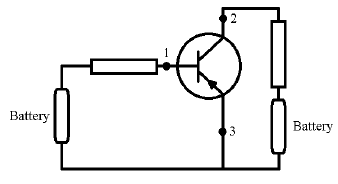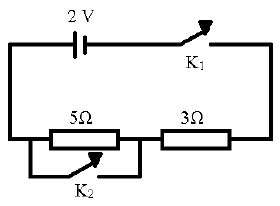THE UNITED REPUBLIC OF TANZANIA NATIONAL EXAMINATIONS COUNCIL
CERTIFICATE OF SECONDARY EDUCATION EXAMINATION 031/1 PHYSICS 1
(For Both School and Private Candidates)
Time: 3 Hours Friday, October 14, 2005 a.m.
Instructions
1. This paper consists of sections A, B and C.
2. Answer all questions in sections A and B and two (2) questions from section C.
3. Electronic calculators are not allowed in the examination room.
4. Cellular phones are not allowed in the examination room.
5. Write your Examination Number on every page of your answer booklet(s).
6. Where necessary use the following constants:
Acceleration do to gravity g = 9.8 m/s2.
Coefficient of linear expansion of brass = 0.000019/°C.
Coefficient of linear expansion of iron = 0.000012/°C. Pi π = 22/7
SECTION A (20 marks)
Answer all questions
1.For each of the items (i) - (x) choose the correct answer from among the given alternatives and write its letter beside the item number.
(i)An auto mechanic wants to measure the diameter of a wire to the nearest 0.001 cm. Which of the following instruments can be used?
- Vernier caliper
- Micrometer screw gauge
- Metre rule
- Pair of compasses
- Engineer's calipers.
(ii)The mass of 1.5 litres of water is ___________ kg.
- 1500
- 150
- 15
- 1.5
- 0.15
(iii)A rectangular wooden block of density 0.8 g/cm3 has dimensions 0.5 m x 0.8 m x 6 m. What maximum pressure will it exert on the ground? ________________ N/m2.
- 48,000
- 4,000
- 2.4
- 19,200
- 400
(iv)Land and sea breezes, ventilation of rooms and cooling systems of refrigerators and deep freezers are associated with one of the following processes of heat transfer
- conduction
- evaporation
- radiation
- expansion
- convection.
(v)A blue dress with red spots when viewed in red light will appear
- completely red
- completely magenta
- blue with red spots
- magenta with red spots
- black with red spots.
(vi) A lens is used to form an image of a bright object on a screen. The effect of covering the top half of the lens with a card is to
- make the image less bright
- make the image go out of focus
- make the image disappear
- remove the top half of the image
- remove the bottom half of the image.
(vii) The size of the induced current in a dynamo depends on the following except
- strength of the magnet
- shape of the magnet
- pressure in the dynamo
- speed of rotation of the coil
- number of turns in the coil.
(viii) A horizontal electron beam passes between two parallel horizontal plates X and Y with X above Y. When a high tension battery is connected with its -ve pole to x and +ve pole to Y, the beam is deflected
- upwards
- downwards at 45° to the horizontal
- upwards at 45° to the horizontal
- sideways
- downwards.
(ix) Which of the following can be common to α-particles, β-particles and γ-rays?
- possess electric charges
- can be deflected by magnetic fields
- can be deflected by electric fields
- can ionize the air
- can be absorbed completely by a very thin aluminum foil.
(x) A transistor in figure 1 is connected in the common-emitter mode. What should be the sign of the potentials at point 1, 2 and 3?
 |
| Fig. 1 |
| Point 1 | Point 2 | Point 3 | |
| A | - | + | + |
| B | + | - | + |
| C | - | - | + |
| D | - | + | - |
| E | + | - | - |
2.Math the words/phrases in List A with the responses in List B by writing the letter of the correct response beside the item number.
| LIST A | LIST B |
| (i) Velocity ratio (VR) (ii) Length, mass and time (iii) Terminal velocity (iv) Thermal conduction (v) Change of speed of light (vi) A region in which a (vii) Beats (viii) Keepers (ix) Fuse (x) Has a narrow forbidden |
|
SECTION B (60 marks)
Answer all questions in this section
3. (a) Mass and weight of an object were determined while on the earth and then when on the moon. Suggest reason(s) for variations shown by any one of the two quantities. (3 marks)
View Ans(b) An object was totally immersed in water.
(i)Identify two (2) different opposing forces acting on the object. (2 marks)
(ii)Write an equation which shows how the two forces can be used to find the relative density of the object. (1 mark)
View Ans(c) A solid of mass 85 g was totally immersed in 30.0 cm3 of water in a measuring cylinder. The level of water in the cylinder rose to 55.0 cm3 mark. Find the:
(i) density of the object
(ii) apparent weight of the object while under water. (4 marks)
View Ans4.(a) A compound strip of brass and iron is straight at room temperature. Draw a labelled diagram to show its appearance when it has been
(i) heated to a high temperature. (ii) cooled below 0°C. (2 marks)
View Ans(b)(i) Define coefficient of linear expansion of a body and state its S.I. units. (2 marks)
(ii) A compound strip of brass and iron, 10 cm long at 20°C, is held horizontally with iron uppermost. When heated from below with a Bunsen burner the temperature of the brass is 820°C and that of the iron is 770°C. Calculate the difference in lengths of the iron and brass. (4 marks)
View Ans(c)State four (4) applications of a bimetal strip (2 marks)
View Ans5.(a) (i) State the laws of reflection. (2 marks)
(ii) State four (4) characteristics of the image formed by a plane mirror. (2 marks)
View Ans(b)Why does a swimming pool appear much shallower than its actual depth? (2 marks)
View Ans(c)Three slabs of different types of glass are placed on a table one on top of the other in the following order from below:
| Refractive index | Thickness |
| 1.4 | 1.2 cm |
| 1.5 | 1.8 cm |
| 1.6 | 0.8 cm |
Where will a mark on the surface of the table appear to be? (4 marks)
View Ans6. (a) State what you understand by the following expressions:
(i) Magnetic field.
(ii) Magnetic lines of force. (2 marks)
View Ans(b) Sketch the lines of force between two (2) bars of magnet placed on a horizontal table with
(i)their N-poles facing each other. (2 marks)
(ii)the N-pole of one facing the S-pole of the other. (2 marks)
View Ans(c) Explain why:
(i)the strength of a magnet cannot be increased beyond a certain limit. (2 marks)
(ii)an increase in temperature weakens or destroys the magnetism of a magnet. (2 marks)
View Ans7.(a) (i) State Ohm's law. (1 mark)
(ii) State two (2) types of electric circuits. (1 mark)
View Ans(b)You have been provided with the resistors of 5 Ω, 10 Ω and 20 Ω. What are the maximum and minimum resistances obtained by connecting those resistors? (4 marks)
View Ans(c)Study the circuit below and then answer the questions that follow.
 |
| Figure 2 |
Calculate the current passing through the circuit when:
(i) Switch K1 is closed.
(ii)Switches K1 and K2 are both closed.
(iii)switch K1 is open and K2 is closed. (4 marks)
View Ans8.(a) The following represents part of the decay chain for thorium

What particles are emitted at each part of the chain? (2 marks)
(b)Identify the type of radiation from the evidence supplied below:
(i)absorbed in a few centimetres of air deflected by a magnetic field (1 mark) (ii) very penetrating rays, not deflected by a magnetic field, harmful to living things. (1 mark)
(iii) mostly absorbed by a few millimetres of aluminum, deflected by a magnetic field. (1 mark)
(iv) has a wavelength of several metres, an aerial is required for the transmission of these waves. (1 mark)
(c) The half-life for the β-decay of thorium – 234 is 24 days. The Physics Department has brought a sample of this thorium from England. On the day of the dispatch its activity was 4 x 105 disintegrations per second.
(i)What was the activity of the source 72 days later? (1 mark)
(ii)What safety precautions should the suppliers take to ensure that none of the dock-workers could be harmed? (3 marks)
View AnsSECTION C (20 marks)
Answer two (2) questions from this section.
9. (a) State:
(i)The principle of moments. (1 mark)
(ii)Pascal's principle of pressure. (1 mark)
(iii)Two (2) devices which apply Pascal's principle. (1 mark)
(b) A hydraulic press has a large circular piston of radius 0.8 m and a circular plunger of radius 0.1 m. A force of 200 N is exerted by a plunger.
(i) Find the force exerted on the piston. State one (1) reason why the weight of the load just raised by the piston is much less than the force exerted on the piston. (3 marks)
(ii) If the plunger is moved through a distance of 0.64 m in exerting its force, through what distance is the piston raised? (2 marks)
(c) A 2.0 N weight placed on a 10 cm mark of a metre rule just balances an object hanging from the 60 cm mark. Calculate the weight of the object. (2 marks)
View Ans10.(a) State the general trends in variations of the following quantities with increasing distances of the planets from the sun.
(i) Average temperatures of the planets. (1 mark)
(ii) Average densities of the planets. (1 mark)
(iii) Period of revolutions of planets around the sun. (1 mark)
View Ans(b)State reasons why an astronaut in space:
(i)needs a special space suit to prevent blood from boiling. (1 mark)
(ii)can float without falling. (1 mark)
(iii)uses small jets of gas in his manoeuvres (movements) instead of swimming like in water. (1 mark)
(c)The distance of Jupiter from the sun is 7.80 x 108 km and one year of Jupiter is equivalent to 12 earth years. Calculate the:
(i) the distance of its path in one Jupiter year.
(ii)speed of the planet in km per hour. (4 marks)
View Ans11.(a) What are the differences between a conductor, semiconductor and an insulator in terms of their energy levels? (3 marks)
View Ans(b)(i) What is the difference between PNP and NPN transistors? (2 marks)
(ii)Draw their circuit symbols, label them and describe each connection. (2 marks)
View Ans(c)Sketch a well labelled diagram of a full PNP stabilized common emitter amplifier circuit. Indicate the components responsible for potential dividers and temperature stabilizer. (3 marks)
View AnsANSWER

Hub App
 For Call,Sms&WhatsApp: 255769929722 / 255754805256
For Call,Sms&WhatsApp: 255769929722 / 255754805256
 For Call,Sms&WhatsApp: 255769929722 / 255754805256
For Call,Sms&WhatsApp: 255769929722 / 255754805256
WHATSAPP US NOW FOR ANY QUERY
App Ya Learning Hub Tanzania





